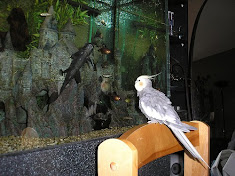Betta splendens (betta fish) have a fairly short lifespan, and are most successful as breeders when they under a year old (bettas in pet shops are usually at least six months old). They breed in bubblenests and do not require a large tank or special equipment. Breeding your betta fish in a good environment is very vital.
 |
| Male Betta Building a Bubblenest by Scott Kinmartin |
The male will blow an elaborate bubblenest when he is ready to spawn. The female should be provided with a hiding place, as males may become aggressive during courtship. Even with a hiding place, it is common for the female to lose a few scales or have their fins frayed during spawning.
When they are ready to spawn, the pair will display intense coloration and begin circling each other under the bubblenest. The male will wrap himself around the female who has turned on her back. As she expels the eggs, they are fertilized and begin to sink. The male will scoop up the eggs and spit them into the nest. From this point on the male will tend the brood. It is advisable to remove the female, as the male may become aggressive towards her as he tends his young.
The male will continue to tend the bubblenest, spitting eggs that fall out back into the nest. In one to two days the eggs will hatch, and the fry will be visible hanging in the bubblenest with their tails pointing downward. They will feed off their yolk sack for another thirty six hours, during which time the male will continue to pick up any fry that fall out of the nest. The male should be removed within two days after the fry hatch, as they may eat the young once they are free swimming. The fry should be fed a couple of feedings daily of baby brine shrimp or very fine baby food. Tetra makes a dry mixture specifically for egglaying fish, and many pet shops carry frozen baby brine shrimp. Take care not to overfeed, as the uneaten food will foul the water and can quickly prove lethal to the fry. Additional information on breeding, raising fry, and photos can be found in the Additional Information section below.
Make sure not to keep two masculine Bettas in a container together because they can fight to death. Females can be kept together though. Many persons think that Bettas cannot be kept with any additional fish but this is not true. Male Bettas and female Bettas can be kept with additional quiet fish genre. Just don't put them in with any aggressive fish that may nip their fins.
Betta fish care and breeding betta fish is not a cumbersome task. It just takes effort, observation and patience.
About the Author: Written by Sylvia Jayakaranvia
Sylvia owns http://www.bettafishcares.com which helps people learn about betta fish care
Source: www.isnare.com
Permanent Link: http://www.isnare.com/?aid=128520&ca=Pets



0 comments:
Post a Comment